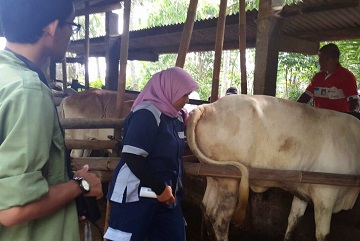A Group of IPB Researchers Developed Methods for Diagnosis and Monitoring of Pregnancy in Dairy Cattle

Gestation detection is an important component of reproductive management, particularly in the dairy industry. The goal is to evaluate the success of Artificial Insemination (IB) caused by Early Embryonic Death (EED). Embryonic mortality is regarded as one of the major causes of reproductive failure in cattle resulting in reduced pregnancy rates, slower genetic improvement and substantial financial losses to dairy and beef production. Embryonic mortality refers to the losses which occur in the period between fertilisation and the completion of the stage of differentiation at approximately day 42. In general, officers detect pregnancy by rectal exploration at 60 days after IB and pay attention to changes in estrus behavior of livestock. After they have been mated, once they pass three weeks without estrus signs they can be presumed pregnant and moved to the gestating area.
A group of researchers of Bogor Agricultural University (IPB), namely Dilla Frastantie, Ligaya I.T.A Tumbelaka, and Muhammad Agil from the Faculty of Veterinary Medicine detected early pregnancy in dairy cows with ultrasound (USG) and steroid hormone analysis.
Ligaya said, errors might occur in detecting pregnancy. If oestrus signs are not observed around 3 weeks after service or insemination, the cow is generally assumed to be pregnant. However, even if oestrus detection is good, not all of these cows will be pregnant. Early identification of non-pregnant cows post breeding improves reproductive efficiency and pregnancy rate in cattle by decreasing the interval between AI services and increasing AI service rate. This will take a long time and result in delays and extensions of time until the return of pregnant again. Various abnormalities responsible for infertility in cows can also be identified. The more common of these include cystic ovaries and uterine infection. The occasional freemartin heifer and other abnormalities of the reproductive organs may also be detected during rectal palpation. Diseases and management problems affecting the whole herd can also be identified much earlier if cattle are pregnancy tested.
She added that rectal exploration is one method of pregnancy diagnosis that can be done on large cattle such as horses, buffalo and cattle. Pregnancy diagnosis by rectal palpation has been performed for decades in cattle. This of course involves an experienced person introducing their hand and arm into the rectum of the cow or heifer and physically feeling the fetus. A skillful palpator can diagnose pregnancy as early as 40 days of gestation and later. It is usually possible to determine the gestation length (or fetal age), although the variation in size of individual fetuses makes it somewhat more difficult as the fetus gets larger. The procedure is the palpation of the uterus through the rectal wall to feel for the enlargement that occurs during pregnancy, the presence of a fetus or a fetal membrane. Sensitivity and habits to recognize the organs is really required for the execution of rectal exploration.
"This technique is known to be quite accurate, fast, and also relatively inexpensive.. Rectal palpation is quick, requires no specialized equipment, gives instant results, and is the most economical of all methods. However, this techniques requires experienced and skillful palpator to diagnose pregnancy correctly. In addition, rectal palpation can help diagnose pathologic problems within the pelvis and abdomen. This technique can only be done at the age of pregnancy above 40 days, "he said.
Early identification of nonpregnant dairy cows and heifers post breeding can improve reproductive efficiency and pregnancy rate by decreasing the interval between AI services and increasing AI service rate. Thus, new technologies to identify nonpregnant dairy cows and heifers early after artificial insemination (AI) may play a key role in management strategies to improve reproductive efficiency and profitability on commercial dairy farms.
"It aims to reduce the costs of breeding programs and help livestock management economically," he said.
The pregnancy examination in this study was performed by two methods: ultrasonography (USG) and steroid hormone (progesterone and estrogen) examination method of blood plasma with ELISA. Ultrasound has the advantage of being able to determine sex of the fetus; however, there is a fairly narrow window in which this can be accomplished. Ultrasound also has the advantage of being able to detect pregnancy earlier than palpation—as early as 28 days of gestation. As many as ten heifers of cattle are examined in dairy farms of Cibungbulang Livestock Farming Area, Bogor. The result of early pregnancy detection showed that five heifers were pregnant and the other five were not.
The results showed that the use of ultrasound can detect pregnancy earlier than the hormonal examination. (Wied)



